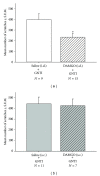Electroacupuncture Attenuates 5'-Guanidinonaltrindole-Evoked Scratching and Spinal c-Fos Expression in the Mouse
- PMID: 23878596
- PMCID: PMC3708416
- DOI: 10.1155/2013/319124
Electroacupuncture Attenuates 5'-Guanidinonaltrindole-Evoked Scratching and Spinal c-Fos Expression in the Mouse
Abstract
The present study was undertaken to investigate the influence of electroacupuncture (EA) on compulsive scratching in mice and c-Fos expression elicited by subcutaneous (s.c.) administration of a known puritogen, 5'-guanidinonaltrindole (GNTI) to the neck. Application of EA to Hegu (LI4) and Quchi (LI11) acupoints at 2 Hz, but not 100 Hz, attenuated GNTI-evoked scratching. In mice pretreated with the µ opioid receptor antagonist naloxone, EA 2 Hz did not attenuate GNTI-evoked scratching, whereas EA at 2 Hz did attenuate GNTI-evoked scratching in mice pretreated with the κ opioid receptor antagonist nor-binaltorphimine. Moreover, intradermal (i.d.) administration of the selective µ opioid receptor agonist [d-Ala2, N-Me-Phe4, Gly5-ol]-enkephalin acetate (DAMGO) attenuated GNTI-evoked scratching behavior, while s.c. administration of DAMGO was ineffective. GNTI provoked c-Fos expression on the lateral side of the superficial layer of the dorsal horn of the cervical spinal cord. Application of 2 Hz EA to LI4 and LI11 decreased the number of c-Fos positive nuclei induced by GNTI. It may be concluded that application of 2 Hz EA to LI4 and LI11 attenuates scratching behavior induced by GNTI in mice and that the peripheral µ opioid system is involved, at least in part, in the anti-pruritic effects of EA.
Figures











Similar articles
-
Manual acupuncture relieves bile acid-induced itch in mice: the role of microglia and TNF-α.Int J Med Sci. 2018 Jun 13;15(9):953-960. doi: 10.7150/ijms.24146. eCollection 2018. Int J Med Sci. 2018. PMID: 30008609 Free PMC article.
-
Nalfurafine prevents 5'-guanidinonaltrindole- and compound 48/80-induced spinal c-fos expression and attenuates 5'-guanidinonaltrindole-elicited scratching behavior in mice.Neuroscience. 2009 Sep 29;163(1):23-33. doi: 10.1016/j.neuroscience.2009.06.016. Epub 2009 Jun 10. Neuroscience. 2009. PMID: 19524022 Free PMC article.
-
Electroacupuncture inhibits pruritogen-induced spinal microglial activation in mice.Brain Res. 2016 Oct 15;1649(Pt A):23-29. doi: 10.1016/j.brainres.2016.07.007. Epub 2016 Jul 8. Brain Res. 2016. PMID: 27396909
-
Investigation of gastrin-releasing peptide as a mediator for 5'-guanidinonaltrindole-induced compulsive scratching in mice.Peptides. 2011 Feb;32(2):286-92. doi: 10.1016/j.peptides.2010.11.022. Epub 2010 Nov 30. Peptides. 2011. PMID: 21126550 Free PMC article.
-
Inhibitory effect of lidocaine on pain and itch using formalin-induced nociception and 5'-guanidinonaltrindole-induced scratching models in mice: behavioral and neuroanatomical evidence.Eur J Pharmacol. 2009 Aug 15;616(1-3):141-6. doi: 10.1016/j.ejphar.2009.06.026. Epub 2009 Jun 21. Eur J Pharmacol. 2009. PMID: 19549515 Free PMC article.
Cited by
-
Antipruritic effect of cold stimulation at the Quchi acupoint (LI11) in mice.BMC Complement Altern Med. 2014 Sep 19;14:341. doi: 10.1186/1472-6882-14-341. BMC Complement Altern Med. 2014. PMID: 25239797 Free PMC article.
-
100 Hz Electroacupuncture Alleviated Chronic Itch and GRPR Expression Through Activation of Kappa Opioid Receptors in Spinal Dorsal Horn.Front Neurosci. 2021 Feb 16;15:625471. doi: 10.3389/fnins.2021.625471. eCollection 2021. Front Neurosci. 2021. PMID: 33664646 Free PMC article.
-
Electroacupuncture improves TBI dysfunction by targeting HDAC overexpression and BDNF-associated Akt/GSK-3β signaling.Front Cell Neurosci. 2022 Aug 9;16:880267. doi: 10.3389/fncel.2022.880267. eCollection 2022. Front Cell Neurosci. 2022. PMID: 36016833 Free PMC article.
-
Manual acupuncture relieves bile acid-induced itch in mice: the role of microglia and TNF-α.Int J Med Sci. 2018 Jun 13;15(9):953-960. doi: 10.7150/ijms.24146. eCollection 2018. Int J Med Sci. 2018. PMID: 30008609 Free PMC article.
-
Acupuncture for the Treatment of Itch: Peripheral and Central Mechanisms.Front Neurosci. 2022 Mar 30;15:786892. doi: 10.3389/fnins.2021.786892. eCollection 2021. Front Neurosci. 2022. PMID: 35431769 Free PMC article. Review.
References
-
- Bergasa NV. Update on the treatment of the pruritus of cholestasis. Clinics in Liver Disease. 2008;12(1):219–234. - PubMed
-
- Carlsson CP, Wallengren J. Therapeutic and experimental therapeutic studies on acupuncture and itch: review of the literature. Journal of the European Academy of Dermatology and Venereology. 2010;24(9):1013–1016. - PubMed
-
- Yosipovitch G, Greaves MW, Schmelz M. Itch. The Lancet. 2003;361(9358):690–694. - PubMed
LinkOut - more resources
Full Text Sources
Other Literature Sources

